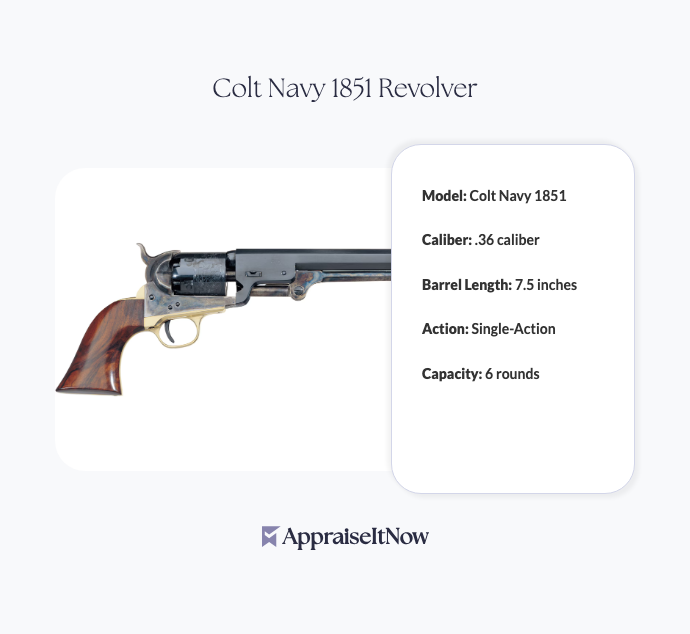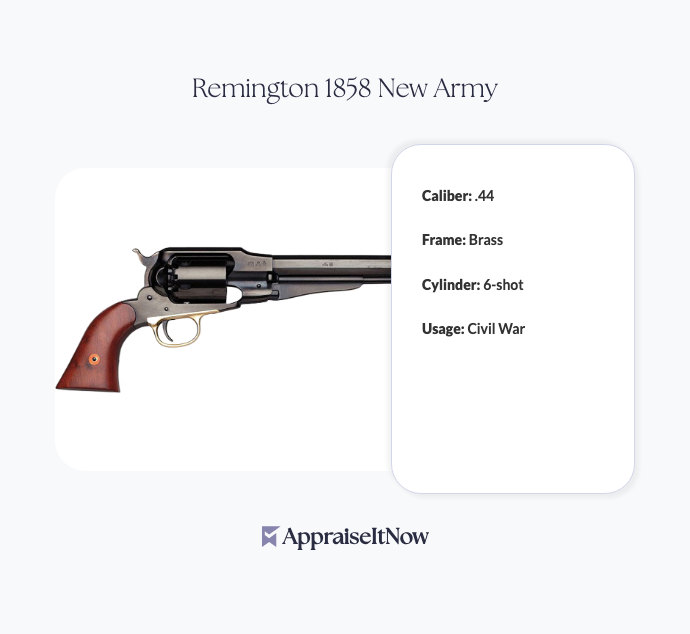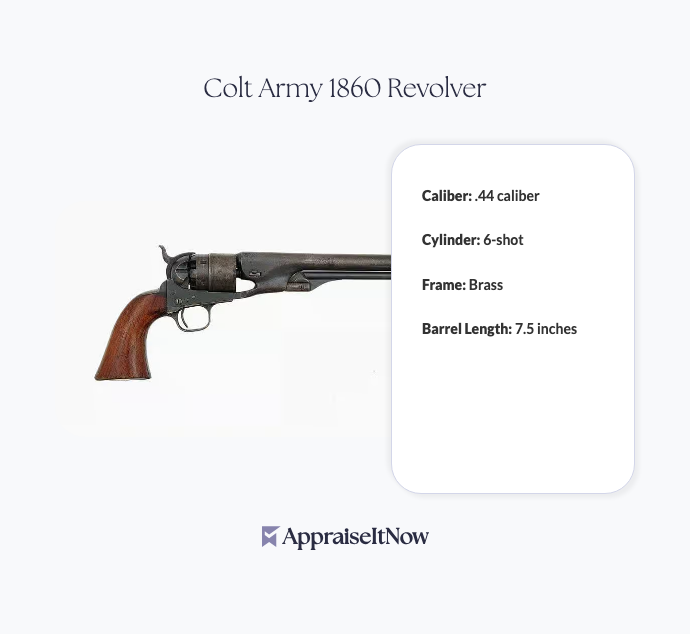<h1>How to Get Your Colt Navy 1851 Revolver Appraised</h1>
<p>The Colt Navy 1851 Revolver stands as one of the most iconic firearms in American history, commanding <strong>$5,000 to $7,000</strong> in today's collector market. Whether you've inherited one, discovered it in an attic, or you're considering a purchase, understanding how to properly appraise this Civil War-era masterpiece ensures you make informed decisions about ownership, insurance, and potential sale.</p>
<h2>Understanding Your Colt Navy 1851's Historical Value</h2>
<p>Your Colt Navy 1851 represents far more than a functional firearm—it embodies a pivotal moment in American military innovation and history. Introduced in 1851, this single-action, six-shot revolver became the preferred sidearm of soldiers during the Civil War, earning distinction among both Union and Confederate forces. Its revolutionary design, featuring an octagonal barrel and sturdy brass frame, solved reliability problems that plagued earlier revolvers, making it the gold standard of mid-19th century weaponry.</p>
<p>The question "How much is a Colt 1851 Navy worth?" depends on several interconnected factors beyond just its age. Collectors seeking authentic pieces understand that the 1851 Navy's legendary reliability and accuracy shaped generations of firearm design that followed. What makes the Colt Navy revolver special? Its proven combat effectiveness during America's bloodiest conflict, combined with its elegant engineering, creates sustained demand among serious collectors of <a href="/types/antique-gun">antique guns</a> and military history enthusiasts.</p>
<div class="callout tip"><p><strong>Collector's Insight</strong></p>
<p>Military provenance—such as documented Civil War service, regiment markings, or soldier attributions—can increase your 1851 Navy's value by 30-50% above baseline market prices.</p></div>
<h2>Key Factors That Determine Colt Navy 1851 Value</h2>
<p>When appraising your revolver, professionals examine multiple technical and historical elements that directly impact worth. Understanding these factors helps you prepare for the appraisal process and recognize what distinguishes a $5,000 example from one commanding $7,000.</p>
<h3>Condition and Authenticity</h3>
<p>The physical state of your Colt Navy 1851 dramatically affects its market position. Original finish integrity matters enormously—pieces with intact bluing or case-hardening commands significant premiums over refinished examples. Matching serial numbers across the barrel, frame, and cylinder indicate the revolver hasn't been pieced together from multiple sources, substantially boosting value and authenticity credentials.</p>
<p>When assessing condition, appraisers look for bore brightness (the interior barrel's clarity), functioning action mechanisms, and original grips showing appropriate wear patterns for age. Heavily worn pieces retain value through historical context, while examples displaying minimal handling command the highest prices. The question "Is the Colt 1851 Navy a good gun?" carries a resounding affirmative—its reputation for dependability means well-maintained examples often shoot as reliably as when manufactured.</p>
<h3>Production Variations and Markings</h3>
<p>Understanding differences between 1851 Navy variants helps explain value variations. How many 1851 Colt Navy revolvers were made? Production numbers exceeded 215,000 units, creating availability that distinguishes the Navy from rarer Colt models. However, specific variations—such as early manufacturing dates, specific markings, or documented military issue—create scarcity within the broader production run.</p>
<table class='appraisal-table'>
<thead>
<tr>
<th>Feature</th>
<th>Impact on Value</th>
<th>Explanation</th>
</tr>
</thead>
<tbody>
<tr>
<td>Serial number range</td>
<td>+10-20%</td>
<td>Early 1850s examples command premiums</td>
</tr>
<tr>
<td>Military markings</td>
<td>+25-40%</td>
<td>U.S. markings, regiment stamps add historical significance</td>
</tr>
<tr>
<td>Original finish</td>
<td>+20-35%</td>
<td>Unmolested, authentic patina highly valued</td>
</tr>
<tr>
<td>Nipple configuration</td>
<td>+5-15%</td>
<td>Specific variations indicate production date accuracy</td>
</tr>
</tbody>
</table>
<p>The Colt 1851 Navy's octagonal barrel design and brass frame remain consistent across variants, but subtle manufacturing differences help dating and authentication. Professional appraisers use detailed knowledge of these variations to position your specific example within market ranges.</p>
<h2>Documentation and Provenance Research</h2>
<p>Before seeking professional appraisal, compile whatever documentation exists for your Colt Navy 1851. Family history narratives mentioning Civil War service, old photographs showing the revolver, or documentation of previous sales provide valuable context. This preparation directly influences your appraiser's ability to establish fair market value and create defensible documentation.</p>
<p>The importance of provenance extends beyond personal interest. When you eventually sell or need insurance coverage, authenticated provenance supports higher valuations and facilitates easier transactions. Museum records, published references in firearms books, or previous auction house documentation significantly strengthen your position in any transaction. Consider how this parallels our approach to valuing <a href="/types/memorabilia-and-collectibles">memorabilia and collectibles</a>—the story behind an object often matters as much as the object itself.</p>
<div class="callout note"><p><strong>Research Strategy</strong></p>
<p>Photograph your Colt Navy 1851 from multiple angles before appraisal, capturing serial numbers, maker's marks, and any distinctive features that tell its unique history.</p></div>
<h2>Colt 1851 Navy vs. Other Civil War Revolvers</h2>
<p>Collectors frequently compare the Navy 1851 to contemporaries like the 1860 Army Colt, which commands different market values. The 1860 Army's larger caliber and slightly later production date create distinct collector appeal, though Navy models often outperform in value appreciation. How much is a 1860 Army Colt worth? These typically range $4,000-$6,500, slightly below Navy pricing due to perceived Civil War service prevalence among Union officers who preferred the smaller Navy bore.</p>
<p>The comparison between different Colt models reveals how historical significance, battlefield adoption rates, and mechanical innovations combine to establish value hierarchies. Your Navy 1851's earlier introduction date and preference among cavalry units contributed to its stronger market position relative to the larger Army variant. Understanding these distinctions helps explain why focused research on your specific model improves appraisal accuracy.</p>
<h2>Why Professional Appraisal Matters</h2>
<p>You might wonder: "Can I determine the value of my Colt online?" While internet searches offer general price ranges, professional appraisal provides certified documentation essential for insurance, legal proceedings, and confident sales transactions. The difference between casual research and professional valuation becomes especially important when dealing with items potentially worth $5,000-$7,000.</p>
<p>Certified appraisers bring expertise that online tools cannot replicate. They understand regional market variations, can identify rare manufacturing details, assess condition using industry standards, and provide USPAP-compliant reports accepted by insurance companies and courts. This professional perspective transforms initial uncertainty into confident ownership decisions, whether you're protecting an inheritance, evaluating an estate asset, or preparing for sale.</p>
<p>When seeking <a href="/blog/benefits-of-hiring-an-antique-gun-appraisal-professional">antique gun appraisal</a> services, look for professionals with specific Civil War and early American firearms expertise. Their specialized knowledge directly impacts appraisal accuracy and defensibility.</p>
<h2>The Appraisal Report and Its Uses</h2>
<p>Professional appraisals deliver detailed documentation serving multiple purposes. Insurance companies require certified valuations to establish replacement cost coverage, protecting your investment if loss occurs. Estate planners use appraised values for accurate asset distribution and tax documentation. Sellers benefit from professionally-supported pricing that facilitates market transactions and prevents undervaluation.</p>
<p>Your appraiser examines not just current market value but the factors supporting that valuation—condition assessment, comparable sales analysis, market trends, and historical context. This comprehensive approach creates documentation standing up to scrutiny from insurance adjusters, attorneys, or potential buyers questioning your asking price. The report becomes your defense against disputes and your foundation for confident ownership or transaction decisions.</p>
<h2>Market Trends for Civil War-Era Firearms</h2>
<p>The broader market for <a href="/types/memorabilia-and-collectibles">memorabilia and collectibles</a> shows consistent appreciation for authenticated Civil War artifacts, particularly firearms. Colt Navy 1851 values have appreciated steadily over the past two decades as collector bases expand and supply of quality examples remains finite. Historical awareness, heritage tourism, and expanding military history interests support sustained demand for these iconic revolvers.</p>
<p>Current conditions favoring Colt Navy 1851 appreciation include decreasing availability of examples in excellent condition, growing collector bases among younger demographics, and stable to increasing values across comparable firearms categories. These market dynamics suggest your revolver represents both a historically meaningful asset and a prudent investment, particularly if well-maintained and properly documented.</p>
<div class="callout tip"><p><strong>Investment Perspective</strong></p>
<p>Historical firearms like the Colt Navy 1851 have demonstrated appreciation rates exceeding general inflation, making professional appraisal valuable from both insurance and wealth-tracking perspectives.</p></div>
<h2>Getting Started with Your Appraisal</h2>
<p>When you're ready to appraise your Colt Navy 1851, AppraiseItNow connects you with credentialed experts specializing in <a href="/types/antique-gun">antique guns</a> and historical firearms. Our certified appraisers hold credentials from recognized organizations including AAA, ISA, ASA, CAGA, and AMEA, ensuring expertise meeting professional standards.</p>
<p>The appraisal process begins with photographing and describing your revolver in detail. You'll submit these materials through our secure platform, where qualified appraisers review the information and may request additional photographs or documentation. Many appraisals proceed entirely online, providing convenient valuation without requiring in-person meetings. For items requiring hands-on inspection, we coordinate scheduling at your convenience.</p>
<p>Our appraisers understand the nuances distinguishing a Navy 1851 from similar models, recognize manufacturing variations indicating production dates and sources, and can identify restoration work affecting value. This specialized knowledge, combined with access to current market data and comparable sales information, produces appraisals accurately reflecting your revolver's true worth in today's market.</p>
<hr />
<div class="callout note"><p><strong>Key Takeaway</strong></p>
<p>A professional appraisal of your Colt Navy 1851 Revolver provides certified documentation essential for insurance, sale, or peace of mind. By understanding the historical significance, condition factors, and market dynamics supporting your revolver's $5,000-$7,000 value, you're equipped to make confident decisions about this iconic piece of American firearms heritage.</p></div>







.avif)







